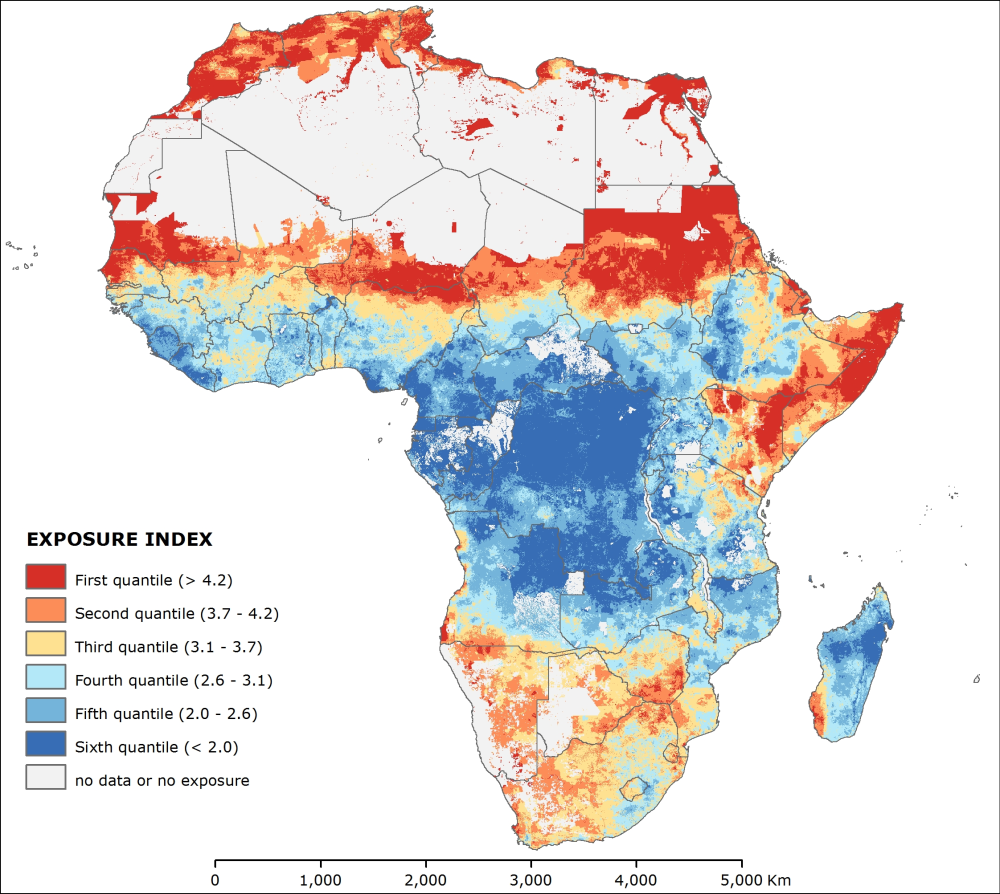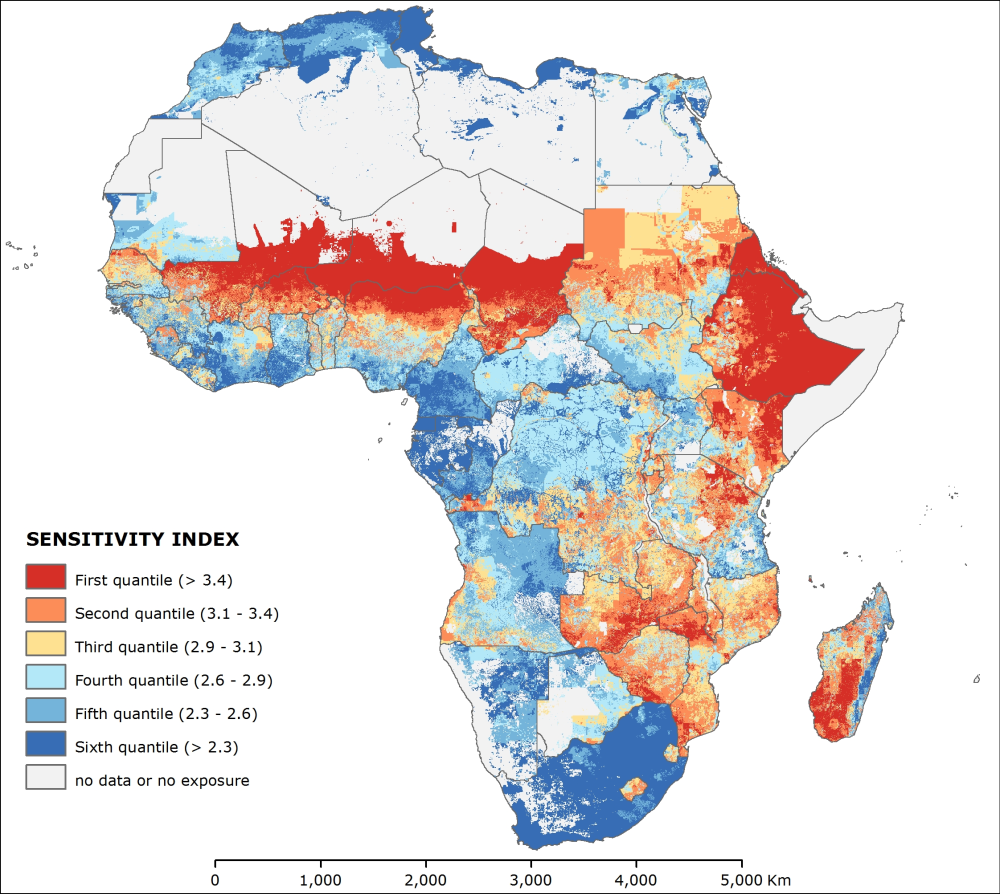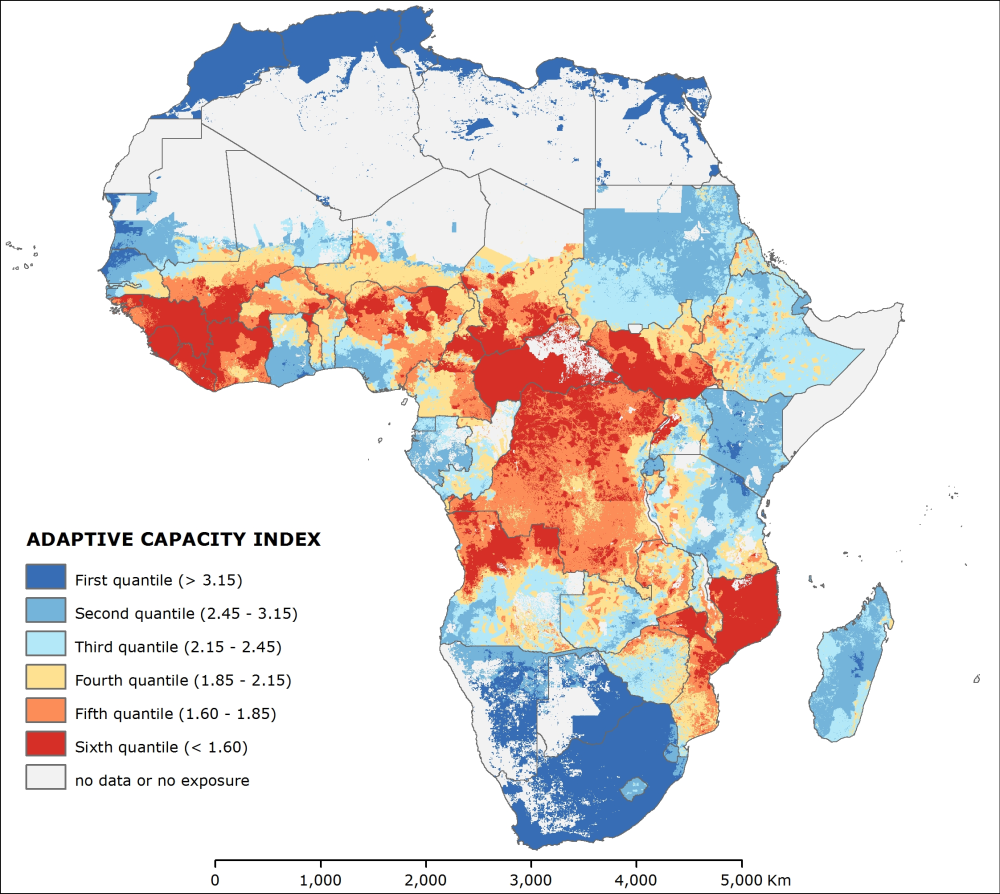vulnerability
Type of resources
Available actions
Topics
Keywords
Contact for the resource
Provided by
Years
Formats
Representation types
Update frequencies
status
Resolution
-

The “exposure index” relates to exposure that is the degree of climatic stress upon a particular unit of analysis or element at risk in 2010. The exposure is commonly defined like the combination between the density of element at risk and a hazard. Here the elements at risk are people, livestock units and crop land and the hazard is the climate change and its impacts. Thus the index results from the addition of two underlying indexes: the “element at risk index” and the “climatic stress index”. The relative weights of underlying indexes were 0.28 and 0.72 respectively for the “element at risk” and the “climatic stress indexes”. These weights were defined through Principal Component Analysis (retaining three components) among ten variables which compose the two underlying indexes. This dataset has been produced in the framework of the “Climate change predictions in Sub-Saharan Africa: impacts and adaptations (ClimAfrica)” project, Work Package 4 (WP4). More information on ClimAfrica project is provided in the Supplemental Information section of this metadata.
-

The “sensitivity index” describes the sensitivity or the human–environmental conditions that can worsen the hazard, ameliorate the hazard, or trigger an impact in 2010. Sensitivity in its general sense is defined as the degree to which a system is modified or affected by an internal or external disturbance or set of disturbances. This measure, which herein reflects the responsiveness of a system to climatic influences, is shaped by both socio-economic and ecological conditions and determines the degree to which a group will be affected by environmental stress. Therefore, the “sensitivity index” results from the addition of underlying indexes, namely the “human sensitivity index” and the “natural sensitivity index”, which relative weights are 0.55 and 0.44, respectively. The weights were computed via Principal Component Analysis among the primary variables that compose the two underlying indexes. This dataset has been produced in the framework of the “Climate change predictions in Sub-Saharan Africa: impacts and adaptations (ClimAfrica)” project, Work Package 4 (WP4). More information on ClimAfrica project is provided in the Supplemental Information section of this metadata.
-

The “adaptive capacity index” symbolizes the adaptive potential to implement adaptation measures that help avert potential impacts in 2010. Adaptive capacity is a significant factor in characterizing vulnerability. The IPCC (2001) describes adaptive capacity as the potential or ability of a system, region, or community to adjust to the effects or impacts of climate change (including climate variability and extremes). Adaptive capacity is considered to be “a function of wealth, technology, education, information, infrastructure, skills, access to resources and stability and management capabilities”. The means of the adaptive capacity are the assets and entitlements that communities and individuals can mobilize in the face of environmental change. The more assets people have, the less vulnerable they are and vice versa. Here adaptive capacity is described as being dependent upon four assets: human capital, technological capital, financial capital and institutional capital. Therefore, the “adaptive capacity index” derived from the addition of four underlying indexes: the “human capital index”, the “technological capital index”, the “financial capital index” and the “institutional capital index”. Principal Component Analysis determines the weights of the four underlying indexes. The analysis run among the variables that compose such indexes and results in four weights: 0.58 for the “human capital index”, 0.16 for the “technological capital index”, 0.20 for the “financial capital index” and finally 0.06 for the “institutional capital index”. This dataset has been produced in the framework of the “Climate change predictions in Sub-Saharan Africa: impacts and adaptations (ClimAfrica)” project, Work Package 4 (WP4). More information on ClimAfrica project is provided in the Supplemental Information section of this metadata.
-

The “vulnerability index” represents the level of vulnerability of a certain region to climate change impacts, given the situation of 2010. The index results from the multiplication of the “exposure index” by the “sensitive index”, and divided by the “adaptive capacity index”. The relative weights were defined through Principal Component Analysis (PCA) among the natural logarithm of the variables which compose the underlying indexes, and they were used like exponential coefficient (0.11 for exposure, 0.33 for sensitivity and 0.56 for adaptive capacity). Alternatively an additive model can be adopted. In this case the PCA run among the underlying variables. However, the result was not significantly different. This dataset has been produced in the framework of the “Climate change predictions in Sub-Saharan Africa: impacts and adaptations (ClimAfrica)” project, Work Package 4 (WP4). More information on ClimAfrica project is provided in the Supplemental Information section of this metadata.
-

The “human sensitivity index” represents the social component of sensitivity in 2010 and it is related to the degree to which a human society is dependent from the agriculture production. It derived from the combination of three underlying indexes: the “rurality index”, the “malnourishment index” and the “gender gap index”. These original indexes resulted from Principal Component Analysis among 14 potential variables, and they represent the three principal component highlighted by such analysis. The analysis allowed compute the weights for the three underlying index as 0.5, 0.3 and 0.2 for the “rurality index”, the “malnourishment index” and the “gender gap index” respectively. This dataset has been produced in the framework of the “Climate change predictions in Sub-Saharan Africa: impacts and adaptations (ClimAfrica)” project, Work Package 4 (WP4). More information on ClimAfrica project is provided in the Supplemental Information section of this metadata.
 FAO Map Catalog
FAO Map Catalog